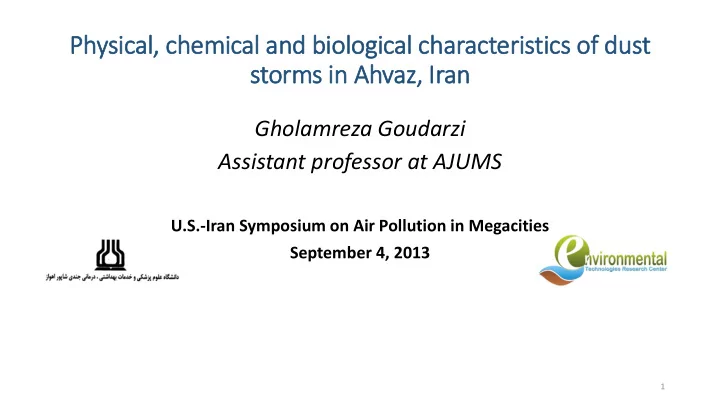

Physical, chemical and bio iological characteristics of f dust storms in in Ahvaz, Ir Iran Gholamreza Goudarzi Assistant professor at AJUMS U.S.-Iran Symposium on Air Pollution in Megacities September 4, 2013 1
Dust storm in Ahvaz 2
Dust storm in Ahvaz 3
Backward trajectory of HYSPLIT model 4
Background • Water Conflicts • Instability and mismanagement in Iraq • Political factors • Climate change RESULT: Desertification & increasing dust event days since 1990 till now 5
Background Number of dust storm days recorded from 1996 to 2009 in selected Khuzestan stations (Zarasvandi,2011). 6
Impacts • Environmental concerns • Social concerns & life quality • Flight cancellation • Crops damage and loss • Health impacts: increasing in asthma, COPD, respiratory and cardiovascular disease • Immigration • Damage to wildlife 7
Area of study (Ahvaz, 31.32, 48.68) Sampling stations in Ahvaz 8
Material and methods: Physical & Chemical • High volume sampler • Portable dust monitor (GRIMM) • Chemical speciation: ICPMS, AA (Ions, Elements) 9
Methods: sampling instrument- biological quick take 30 th Samples collected every 6 day Sampling height= 1.5m Sampling time=2-15 min 10
Biological Analysis Bacteria Fungi • TSA • PDA Sterilization of bio stage by alcohol Sterilization of biostage by alcohol putting petri dish inside bio stage putting petri dish inside biostage Sampling Samling culture dishes were incubated in culture dishes were examined after 72 -96 36±0.5 degree of Celsius. hours at room temperature 11
Biological • Identification of bacteria was conducted using macroscopic, microscopic examination of gram-stained smears and standard biochemical tests. • Besides, the spore staining and acid-fast staining were used to identify Bacillus and Nocardia genera, respectively. Enterobacteriaceae was identified using API kit. • Identification of fungi was performed according to micro- and macro morphological characteristics. 12
Peak: June and July PM10 Conc. reached over 1800 Results PM2.5 Conc. reached over 450 Temporal trends in daily average PM10, PM2.5, and PM1 concentrations over the study period in Ahvaz (Shahsavani, et al) 13
Results Peak: from May to July for both Conc: over 5000 for PM10 and over 4500 for PM2.5 Temporal trends in maximum values of PM10, PM2.5, and PM1 concentrations over the study period in Ahvaz (Shahsavani et al) 14
Total ion/TSP= 9.5% Total ion/PM10= 11.3% Result- Ions Table 3. Summary statistics for mean total mass concentrations of TSP and PM10 and their ionic components over the study period in Ahvaz (shahsavani et al, 2011) 15
EF>10 could possibly associated with Result-chemical anthropogenic sources Khuzestan airborne dust samples: values of element enrichment factor (EF) in different particles (Zarasvandi,A. et al,2011) 16
1.5-3 Result-biological (fungi) Concentration of total fungi (CFU m-3), temperature (C) and relative humidity (RH %) measured during normal and dust event days in three seasons in Ahvaz (Soleimani,Z. Goudarzi, G. Aerobiologia.2013). 17
Result- biological (fungi) Percentage of fungi isolated in three seasons sampling during normal and dust event days (Soleimani,Z. Goudarzi, G. Aerobiologia.2013). 18
Result – biological (bacteria) Percentage of indoor and outdoor bacteria isolated during normal and dust event days in Ahvaz (Soleimani,Z. Goudarzi, G. Aerobiologia.2013). 19
Concluding remarks • Overall mean values of 319.6 ± 407.07, 69.5 ± 83.2, and 37.02 ± 34.9 µg/m3 were obtained for PM10, PM2.5, and PM1, respectively, with corresponding maximum values of 5337.6, 910.9, and 495 µg/m3. • The presence of the westerly prevailing wind implied that Iraq is the major source of dust events in this area. • A total of 72 dust days and 711 dust hours occurred in the study area. The dust events occurred primarily on June and July. • The longest dust event during the study period occurred in July, lasted five days, and had a peak concentration of 5338 µg/m3. These high concentrations produced AQI values over 500. 20
Concluding remarks • The dominant ions were: Ca 2+ , Mg 2+ ,Cl - , NO3 - ,SO4 2- • Chemical analysis showed that main elements had crustal origin • However, some of heavy metals such as Ni, Ca, and Ba derived from non-crustal sources • Concentration of biological agents, particularly fungi, during dust event days was higher than those levels in normal days 21
Acknowledgements • Funding • ETRC (Environmental Technologies Research Center) • AJUMS (Ahvaz Jundishapour University of Medical Sciences) • Collaborators • Professor Batool Sadeghi nejad • Zahra Soleimani • Najmeh Parhizgari • Professor Alireza Zarasvandi • Professor Abbas Shahsavani • Professor Kazem Naddafi 22
Special thanks to: • The organizer and sponsors of the program • Dr. Glenn Schweitzer, Mr. Larry Moody and his colleagues, Dr. Norman Neureiter, Ms. Lindsey Marburger, Prof. Najmedin Meshkati, Prof. Sorooshian ,… and many other friends • The distinguished American scientists (speakers) • UC Irvine and USC • All places we visited and all persons we met. • The International Visitors Councils of Washington D.C, Raleigh, Pittsburg, Los Angeles • World learning • American Association for the Advancement of Science 23
Thank you 24
Recommend
More recommend